STRANGE TALES #140
 “The End of Hydra!”
“The End of Hydra!”
Script: Stan Lee
Layouts: Jack Kirby
Pencils: Don Heck
Inks: Joe Sinnott
Letters: Sam Rosen
IN A NUTSHELL
Fury and Imperial Hydra’s daughter disable the hunter robot while Dum Dum leads a SHIELD strike force against Hydra. Hydra’s skateboard unit ambushes Dugan, but when Fury arrives, they wipe out Hydra’s force. The Imperial Hydra—revealed as Arnold Brown—faces his only option: Operation Last Resort, which will destroy his daughter along with Fury. Meanwhile, Tony Stark uses the Braino-Saur to deactivate Hydra’s Betatron Bomb.
WHAT’S HOT
HAIL MARY. I love the supreme drama of Tony Stark’s attempt to stop the betatron bomb. He has only one attempt to get it right, and if he doesn’t, not only is it the end of his life, but the end of all life on earth as we know it. Whew! Even Charlie Brown on the pitcher’s mound never had it this tough!
THE BUTLER DID IT. I’ve noted before that despite previous attempts to point the reader in the direction of dictatorial Farrington as Imperial Hydra, I suspected his meek assistant, Mr. Brown. And turns out I was right! Am I good, or what? (Or maybe this was too easy…?)
WHAT’S NOT
EXPECTATION DENIED. The cover promises “The End of Hydra,” but the story ends on a cliffhanger. Imperial Hydra is about to press a button that will destroy the entire organization (including his daughter), but that never actually happens in this issue. Now, it’s possible he pushes the button on the first page of the next issue, but even if he does…what’s the saying? “Cut off one head and two more shall take its place!” I’m not buying what the cover is selling.
HOW 2005 OF YOU… Hydra squads get around on “skateboards.” My teenage son was excellent with a skateboard, so I know a bit about what a skateboard looks like, and it don’t look like a random piece of lumber on a couple of wheels, as depicted here. When I was a kid in the 1960’s, my brothers and their friends did not use skateboards, but still, I feel fairly certain skateboards didn’t look like this. Is it possible in 1966 that neither Don Heck nor Jack Kirby had ever actually seen a skateboard, and just drew what they imagined it would look like, based on the juxtaposition of the words “skate” and “board”? Wouldn’t Hydra have some cool tech to devise transportation devices that looked much more like the Green Goblin’s glider than something a Depression-era kid would have put together from junk yard scraps?
I WONDER…
PAL, BUSTER, MISTER. In the first SHIELD installment (Strange Tales #135), Fury meets a clean-cup fellow in a green suit who is never given a name but ends up taking him around in a flying car, and I immediately wondered if this might be Agent Phil Coulson. In this issue, Stark is escorted by a similar looking chum who seems to know a lot about Fury’s initial trip to the heli-carrier. So I’m still wondering if this is Coulson. With the information I have so far, the laws of logic do not preclude this possibility. Of course, further reading may shed more light on this mysterious SHIELD employee, but until I am convinced otherwise, I’m keeping Coulson in my back pocket.
“It seems we have underestimated the Agents of SHIELD!”
— Hydra Minion

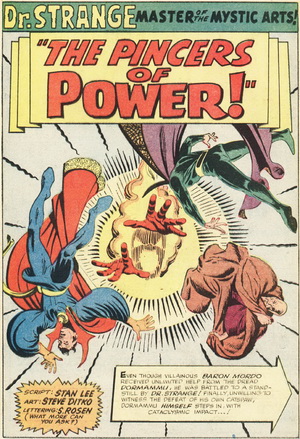 “The Pincers of Power!”
“The Pincers of Power!”
Script: Stan Lee
Art: Steve Ditko
Letters: Sam Rosen
IN A NUTSHELL
Growing impatient with Mordo, Dormammu transports Strange and the Ancient One to a neutral dimension, then summons the Lords of the Netherworlds to witness combat between himself and Strange, with mastery of Earth going to the victor. They engage in a duel, using only the Pincers of Power. Strange uses judo to defeat Dormammu, but before he can claim victory, Mordo strikes from behind, laying Strange low. Dormammu rises to stand over the fallen Strange.
WHAT’S HOT
POETRY. Dr. Strange, Mordo and the Ancient One go to “a lonely, lifeless dimension at the end of infinity.” I’ve said it before about this title, and I’ll say it again: sheer poetry!
JUDO VOODOO. In the end, Strange defeats the mighty Dormammu with a simple Judo chop! Yay, Earth!
WHAT’S NOT
HONOR AMONG VILLAINS? PART 1. Dormammu sets “total mastery of all of Earth” as the prize. But is that really his to offer? And more importantly, if Dormammu loses the fight, why should Strange trust that he’ll simply give up all dreams of total mastery of all the Earth?
HONOR AMONG VILLAINS? PART 2. After Strange defeats Dormammu, Mordo steps in and illegally takes down his master’s enemy. Hey, not fair, that wasn’t in the rules!
“Only for those without faith can there be no hope!”
— Ancient One

TALES OF SUSPENSE #73
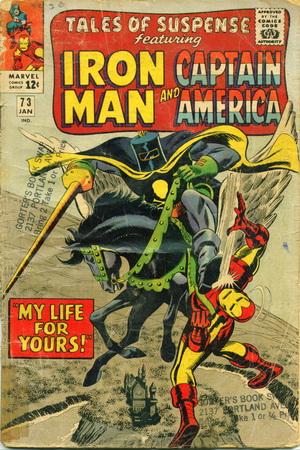 “My Life For Yours!”
“My Life For Yours!”
Plot: Stan Lee
Script: Roy Thomas, Flo Steinberg
Pencils: Adam Austin
Inks: Sol Brodsky, Gary Michaels
Letters: Art Simek
IN A NUTSHELL
Iron Man arrives at the hospital just in time to discover that Happy has been abducted. He follows clues to the Black Knight’s castle, where the ensuing battle causes a malfunction in his armor. The fight ends with both antagonists falling from a height. Iron Man lands in a lake and pulls himself ashore. With his last reserves, he calls for help. The police arrive and rescue Happy, but don’t notice Iron Man, leaving him helpless.
WHAT’S HOT
LOOKIN’ GOOD! I believe in the past I have not been a fan of Adam Austin’s artwork, but allowed at that time that it could have been a heavy-handed inker causing my discontent. Here, artist and inker are working in complete harmony as they offer a prettier Pepper Potts than any I have yet seen.
SOME OF THE LANGUAGE IN HERE JUST SLAYS ME. My understanding is that while Stan Lee wrote the story, Roy Thomas penned the script. Kudos for over-the-top dramatic language such as “watching, mocking, waiting,” and “perplexed, confused, bewildered.” Where comic books and poetry meet.
ANCESTORS. It was a nice touch when Iron Man walks down the quiet dark hallway of the castle. Not only do we get the sound effects of metal upon stone (“Clank! Clank!”), but also that part of Tony Stark that IS Iron Man muses that some of the suits of armor lined up along the walls evoke a feeling of “ancestors” within him. More poetry?
WHAT’S NOT
CLUELESS COPS. This happens all the time, so I really shouldn’t be so picky, but does anyone else think it doesn’t look good for the local cops when a patient disappears out of a guarded third-floor hospital room and none of them think to check the open window? Of course they wouldn’t be looking for hoof prints, but surely they would not miss seeing them?
LAY OF THE LAND. Are there really castles 30 miles away from Washington DC? And are they abandoned, just waiting for a super-villain to take up illegal residence?
BEEN THERE, DONE THAT. Iron Man must fight multiple images of the Black Knight. Hmmmm…haven’t I see this before? But another question: couldn’t Iron Man’s technology differentiate between real matter and a mere image?
IRONY MAN. At the end of the story, when the cops come in to rescue Happy, one of them asks shouldn’t they be looking for Iron Man as well, and his fellow officer replies, “No time to worry about him. And anyway…we all know he’s INVINCIBLE!” Iron Man really could have used some help at this moment, but his reputation, unfortunately, precedes him. Ouch!
“Flying horses don’t leave hoofprints
on window-sills without a reason!”
— Iron Man

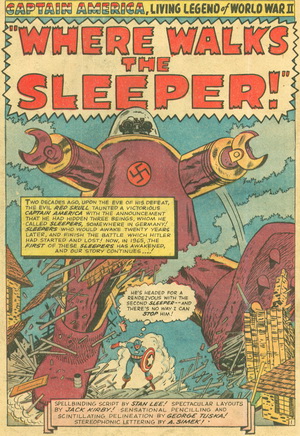 “Where Walks the Sleeper!”
“Where Walks the Sleeper!”
Script: Stan Lee
Layouts: Jack Kirby
Art: George Tuska
Letters: Artie Simek
IN A NUTSHELL
Cap buries the first Sleeper under a rockslide, but it only briefly delays the Sleeper’s march to match up with the second Sleeper. Meanwhile, the woman known as Agent 2 instructs her agents to detonate a bomb that releases the second Sleeper, a flying mantis-shaped robot which destroys a nearby deserted town. Cap boards the second Sleeper but cannot prevent the two Sleepers from connecting. NATO planes attack the Sleepers, forcing Cap to abandon his perch, dropping into the sea.
WHAT’S HOT
DIVERSITY. I was pleased to see that the second Sleeper was different than the first, that we were not in for a small army of identical robots. The mechanical cradle on top of the “stingray” Sleeper makes me wonder what the third is going to look like.
AS EXPECTED. When Cap narrowly escapes falling off a cliff, there is never any doubt he will survive. In the same way, it’s no surprise when he ultimately exclaims, “I’ve been given a second chance! I must make sure that I’ll prove worthy of it!” The lack of suspense could have been classified as “Not” rather than “Hot,” but points given here because these words are spoken like a true superhero.
NATO. Not sure exactly what kind of message Cap was able to SOS with his shield and the sun, but it quickly produced help from the allies. Go, NATO!
WHAT’S NOT
YOU SNOOZE, YOU LOSE. If the Red Skull and/or Nazi Germany possessed technology to create such fearsome and invincible machines like the Sleepers, why didn’t they use it right away in 1945? And why wait twenty years? Why not five, or one, or even six months? After twenty years in hiding, technology might get rusty, and superseded by much more sophisticated technology. On the whole, this doesn’t seem like a very good plan.
PAWN BROKER. Speaking of twenty years…why did the pawn shop hold on to Agent 3’s mysterious object for so long? What kind of business model is this: sure, give me your crazy junk, I’ll hold it for twenty years for free, then give it back to you when you return. Where’s the upside for the pawnbroker? And is it possible that in all that time the pawnbroker never tried to turn the key? None of this works for me.
PASSING THE GAS TEST? Agent 3 douses the pawnbroker with a gas that is not designed to kill him. The pawnbroker clearly displayed his contempt for the Third Reich, yet Agent 3 allows him to live. What kind of villain is this? This display of tenderheartedness takes all the gas out of the Nazi balloon.
“She is surely mad! But, she pays us well!”
— Digger

JOURNEY INTO MYSTERY #124
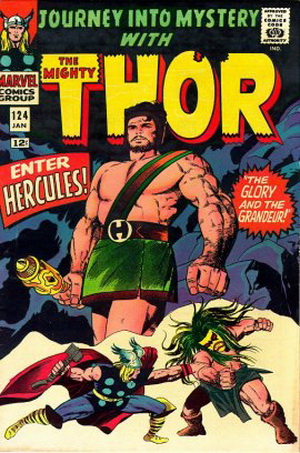 “The Grandeur and the Glory!”
“The Grandeur and the Glory!”
Script: Stan Lee
Pencils: Jack Kirby
Inks: Vince Colletta
Letters: Artie Simek
IN A NUTSHELL
After a brief interlude with the citizens of New York, Thor changes into Blake and visits Jane in the hospital. Jane is suffering from depression because Blake is always leaving her and she believes he is hiding something from her. Blake reveals his secret identity to Jane, enraging Odin. Later, Blake hears of the Demon’s recent exploits in Asia, and decides he must fight the Demon, even though it means leaving Jane again. Meanwhile, on Mt. Olympus, Zeus instructs Hercules to find challenges on Earth.
WHAT’S HOT
TRY A LITTLE TENDERNESS. Thor is a big strong superhero, but we see here he takes a moment to speak softly and kindly with a child whose father is fighting in Viet Nam. Sort of brings a tear to the eye…
END OF HER ROPE. Jane simply…can’t…take it…anymore. In no uncertain terms, she tells Blake/Thor that she’s had as much as she can take and doesn’t want to see him anymore. What an emotional, heartfelt and totally realistic scene! (Except, of course, for the part when her frustrating love interest reveals himself to be an actual god.) But I think every one of us can recall some incident in our past, be it with a lover, boss, friend or foe, when we also have reached the proverbial end of our rope.
GLOBALISTS. The common man is obsessed with the news from Asia. The powers on Mount Olympus are getting involved. Thor himself joins the fight despite his recent promise to Jane. Though many Marvel villains may have lusted after World Domination, I don’t know that I’ve ever seen the world unite so strongly against a single crazed despot.
WHAT’S NOT
THE UNSETTLING SETTING. Nothing can harm the Demon as long as he maintains possession of the Norn Stone. I realize this is a primitive culture, but surely there is a better way to secure this precious object than with what appears to be nothing more than a single piece of string.
MALPRACTICE. When Blake visits Jane in the hospital, he diagnoses her to be suffering from both depression and hysteria. Is this really the best time to whip out his magical transformation from man to god? Is he trying to add “shock” to her list of ailments?
BY ANY OTHER NAME… His followers call him “The Demon.” Do they realize the connotation? Does it concern them that they fight on the side of Evil? Or is this a case of not caring whether a leader stands for right or wrong, as long as they represent the accrual of power?
CLAUSTROPHOBIA. We spend the first two pages of this story following Thor around on the streets of New York, where he reads the newspaper, hugs a child, rides an elevator and has a disagreement with a policeman. I recognize that all of this takes place to humanize him, and also as a stab at comedy. But the comedy falls flat for me. Huge Thor with his billowing red cape in the crowded New York City landscape fills me with not a sense of delight, but rather claustrophobia. When he finally takes the entirety of page four to escape the confines of city life and begin his adventure, it’s quite a relief.
“No matter what my heart dictates—
the call of duty speaks louder still!”
— Thor

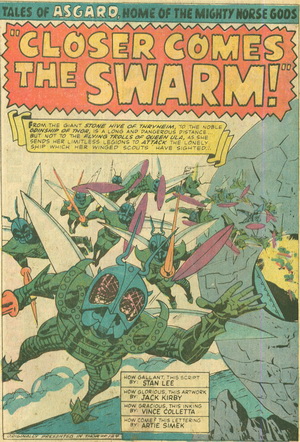 “Closer Comes the Swarm!”
“Closer Comes the Swarm!”
Script: Stan Lee
Pencils: Jack Kirby
Inks: Vince Colletta
Letters: Artie Simek
IN A NUTSHELL
Queen Ula’s flying trolls travel from the stone hive of Thryheim to Thor’s Odinship, eager to do battle with the Asgardian sailors. On the Odinship, having defeated the Utgard Dragon, Thor lowers Balder from his perch, and Hogun gives Balder an elixir to revive him. Meanwhile, Loki continues scheming with Magrat and Kroda to lead a mutiny over Thor’s leadership. Continuing the celebration, Volstagg tries to blow Balder’s horn, unaware that Ula’s trolls gather on the horizon behind him.
WHAT’S HOT
NOW THAT’S COMEDY! What our first story could not achieve in the way of amusing city street tableaus is finally brought to fruition in one brief moment in this Tale of Asgard, when Stan makes an editorial note that Balder has collapsed from the exertion of “tooting his enchanted horn last issue, remember?” A few simple words, unexpectedly dropped in the middle of an epic storyline. Works for me.
WHAT’S NOT
METHINKS THOU DOTH CELEBRATE TOO MUCH. When the exhausted Balder is revived by the Elixir of Recovery, his shipmates are so excessively pleased that they look like they’re ready to party like it’s 1999. Is love for Balder really that strong…or have they all been at sea so long that they’re looking for any excuse to break out the grog?
“Stop!! Sheath thy weapons!!
Surely I did not play the horn so badly!!”
— Volstagg

FANTASTIC FOUR #46
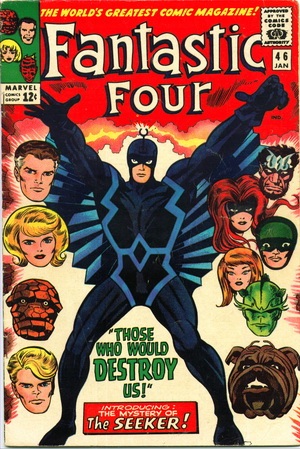 “Those Who Would Destroy Us!”
“Those Who Would Destroy Us!”
Script: Stan Lee
Pencils: Jack Kirby
Inks: Joe Sinnott
Letters: Artie Simek
IN A NUTSHELL
While Thing battles Black Bolt, Reed fights Triton and deduces that Triton is weakened without exposure to water. No sooner does Reed defeat Triton than Karnak enters the fray. Meanwhile, the Seeker invades the Baxter Building and captures Dragon Man, mistakenly believing that the android is another Inhuman. Back at the scene of the battle, Thing defeats Black Bolt, but Lockjaw arrives and teleports the Inhumans away, separating Crystal and Johnny. Later, Dragon Man escapes, free to run amok.
WHAT’S HOT
OH MY DARLING, OH MY DARLING… It’s so cute how now that Reed and Sue are married, they keep calling each other “Darling,” “Honey,” and “Dear,” even in the midst of a most intense superhero crisis.
TEENAGERS IN LOVE. Mere hours ago, Johnny just got his heart handed to him on a platter by former girlfriend Dorrie. He’s obviously still in shock, on the rebound. He and Crystal have only just met…also mere hours ago. Yet there’s this sudden, strong, love-at-first-sight infatuation that causes both of them to get nearly hysterical when it appears they will be parted without even so much as a “Fare thee well!” Sigh…
SILENT SPARRING. Thing notes that Black Bolt has nothing to say as they spar. At first, he’s appreciative (“This is a pleasure!”), then curious, and finally frustrated. I enjoyed the natural progression of these responses. And of course, to the first-time audience of 1966, by the end of this issue, they still have no explanation. If this story alone was not enough to keep readers coming back for more (and it is), at the very least they would have to buy the next issue to find out the answer to the mystery of why Black Bolt is the epitome of “the strong silent type.”
WHAT’S NOT
SLOPPY WRITING #1: F.F.? Upon finding Dragon Man napping in F.F. headquarters, the Seeker’s minion asks, “How did the F.F. ever get him in here?” To me, the bigger question is, “Did that guy really just say ‘F.F.’?” It’s a sloppy shortcut on the part of the letterer. You might get away with this in the Narrator’s box, but word balloons should be accurate. If not, then why such great attention to writing out Thing’s speech patterns as “ain’t gonna,” “kinda” and “all I gotta do”?
SLOPPY WRITING #2: MORE INFO, PLEASE! The Seeker’s explanation of the origin of the Inhumans is a tad confusing. The way I interpret his narrative, there are: 1) Mere humans—whom the Seeker clearly identifies as the lowliest, 2) his race, which is far superior, as they are able to “produce Inhumans” by using “vari-genes, to control evolution,” and 3) the actual “produced Inhumans.” So…what race is the Seeker? Humans are below him, Inhumans are his “product,” but what do we know about him, his race, where they come from, and what else they can do, besides “produce Inhumans”? I realize more information may yet be coming, but I’m disappointed by the holes in this long-awaited explanation.
SLOPPY WRITING #3: WHO?? Also (and now I feel I’m being very picky, but this is a legitimate point), when the F.F. arrive at the Seeker’s lair, he tells them, “I know why you have come! You wish the return of the one called Dragon Man!” Only, up to that point, the Seeker has not heard anyone use the name “Dragon Man.” So how does he know it? Unless the Seeker has as yet unrevealed superpowers that allow him to know things before they can be known under ordinary circumstances? If so, then again I say…sloppy writing!
“Johnny! Johnny! I don’t want to leave you!
I want to stay with you—no matter what—! Johnny—!”
— Crystal

AVENGERS #24
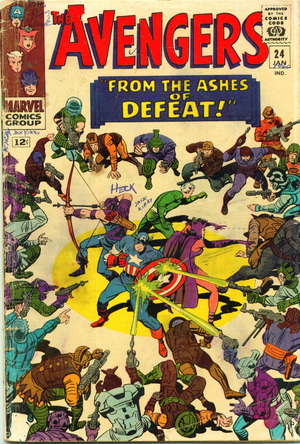 “From the Ashes of Defeat–!”
“From the Ashes of Defeat–!”
Script: Stan Lee
Pencils: Don Heck
Inks: Dick Ayers
Letters: Artie Simek
IN A NUTSHELL
Embittered by Ravonna’s rejection, Kang vows to conquer her kingdom, but Captain America inspires Ravonna’s army to keep fighting. Quicksilver is injured by Kang’s delta rays, and a young mother provides shelter for him. Kang’s forces overwhelm the remaining Avengers, and Kang demands Ravonna’s hand in marriage. When Kang’s army revolts, he joins forces with the Avengers to save Ravonna. Just as Kang returns the Avengers to the present in gratitude, his mutinous general seemingly kills Ravonna.
WHAT’S HOT
GREATEST STORY EVER TOLD. By the time I got to the end of this story, I had decided that this was the most exciting, compelling and complex Marvel Comics story I have read to date. It has everything from epic battle scenes to heartwarming personal tableaus along with unexpected plot twists. Two dimensional characters are now more three dimensional, and larger than life issues of morality are tackled head on. It all works. What’s not to like?
FIGHT FOR RIGHT. Why do the Avengers fight this battle in the future? The outcome will have no direct impact on their personal situation. They fight because it is right. This is what heroes do.
THE MOTHER AND CHILD REUNION. Quicksilver briefly breaks to assist an ordinary family. Yes, it’s a trope, but does that make it any less powerful? We in the early 21st century may sometimes balk at blatant attempts to pull on our heartstrings, but unless you are made of stone, this kind of personal story still works on some level.
NOW IN 3D! I had a firm opinion of Kang at the beginning of this story, but by the end, all that was completely obliterated. I especially liked the three panels on page 13 that zoom in closer and closer to show what is truly motivating him. Though it may be hard to believe a despot like Kang knows anything of true love, we are left with no doubt that as much as he is able, he loves the Princess Ravonna and is willing to do anything he can to save her. Up til this point, I figured Kang’s “love” for Ravonna was nothing more than a desire to possess her. But now his actions have proven me wrong. (“Don’t listen to what they say…watch what they do.”)
WHAT’S NOT
TRY NEW SHIMMER! I always get a kick out of what I call the “30-Second Persuasion” often heard in TV and radio commercials, where a simple sentence or two completely turns around a doubter’s opinion in no time flat. In a very busy panel on the top of page 4 Captain America turns the upper brass of Ranonna’s army from wimps to war hawks in a matter of 36 words. I understand the confines of storytelling don’t allow for a slow and natural evolution of political thought, but still, it’s amusing to see how quickly and effortlessly the natives are influenced. (Oh, if only it could be so easy today!)
CLASSIC VILLAIN MISTAKES. I love classic villain mistakes…and there are several in this story. Kang decides to imprison the Avengers rather than immediately kill them. When his underlings threaten a coup and remind him of the Law (which he feels he is above), rather than slay the usurpers on the spot, he gives them one hour to reconsider their position. A TRULY villainous villain would not be so conciliatory or open to negotiation. Of course, storybook villains must behave in this way…or there will be no story worth telling! But it still rankles me whenever I see it happening.
THE FUTURE OF SEXISM. Okay, it’s what? The 30th century? And the locals still snidely assume all females in battle are by nature “powerless”? ::rolls eyes::
JUST FOR FUN
CAN DISH IT OUT, BUT CAN’T TAKE IT. I also got a kick out of Cap telling Hawkeye, “Listen Robin Hood—skip the sarcasm till this shindig is over!” Never mind the colloquialism of the word “shindig.” Isn’t Cap himself being a bit sarcastic by calling Hawkeye “Robin Hood”?
EASTER EGG. Another fun little moment occurs when Kang hears the name “Dr. Doom” and muses “Little do they know how closely related I am to the greatest arch-villain of all time! But, there is no time for that now—!” We of course remember that way back in Fantastic Four Annual #2, Dr. Doom and another time traveler had a fabulous scene where they met and contemplated that they might be the same person. Tacking on “But, there is no time for that now—!” leaves the matter open for another time for the paradox to be once again considered. Stay tuned!
“Captain America’s words make me proud to be an Avenger!”
— Scarlet Witch

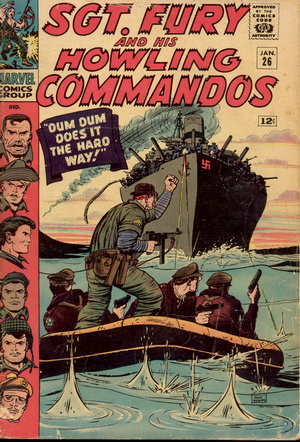

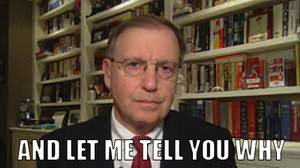
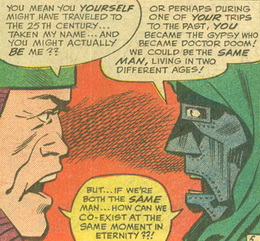 again, not letting it die on the heap of loose plot threads. I anticipate that, with this dilemma now coming up twice, we will run into it again. And when that happens, it will be fun to see what Marvel does with it.
again, not letting it die on the heap of loose plot threads. I anticipate that, with this dilemma now coming up twice, we will run into it again. And when that happens, it will be fun to see what Marvel does with it.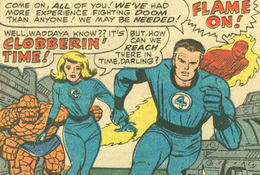 Marvel was willing to contemplate the controversial question of the role of the superhero in organized society. Here, as in Civil War, I can heartily appreciate both viewpoints, and still can’t definitively say I come down on one side or the other. But I applaud Marvel for not shrinking away from this delicate yet very important issue.
Marvel was willing to contemplate the controversial question of the role of the superhero in organized society. Here, as in Civil War, I can heartily appreciate both viewpoints, and still can’t definitively say I come down on one side or the other. But I applaud Marvel for not shrinking away from this delicate yet very important issue. 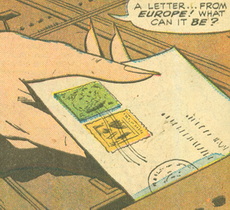 enough to recognize that as superheroes, they might be subject to the nefarious whims of no-good-niks, and can’t necessarily trust every incredible invitation that arrives in the mail.
enough to recognize that as superheroes, they might be subject to the nefarious whims of no-good-niks, and can’t necessarily trust every incredible invitation that arrives in the mail. 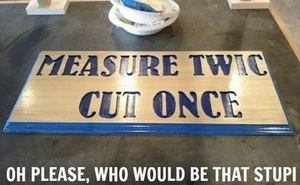 Did they all really travel to a foreign country without first doing at least a little research on their destination? I mean, Russ and I won’t even go to a new restaurant without first checking the website, the menu, reviews on Yelp and Tripadvisor, and also the state-issued Health Department rating! Now granted, the Avengers of the 1960’s do not have access to the wonderful conveniences of the internet, but surely it would have been easy enough to find out before you travel whether your destination is ruled by a benevolent statesman or a power-hungry despot!
Did they all really travel to a foreign country without first doing at least a little research on their destination? I mean, Russ and I won’t even go to a new restaurant without first checking the website, the menu, reviews on Yelp and Tripadvisor, and also the state-issued Health Department rating! Now granted, the Avengers of the 1960’s do not have access to the wonderful conveniences of the internet, but surely it would have been easy enough to find out before you travel whether your destination is ruled by a benevolent statesman or a power-hungry despot!  Hello! Was there no catalog of back issues to check? If there was scant time for research, couldn’t you put your Girl Friday on the task?
Hello! Was there no catalog of back issues to check? If there was scant time for research, couldn’t you put your Girl Friday on the task?  Really. In the end, it’s a sneeze that saves the day. And the story is over. The Avengers go home, and Doom apparently goes back to dreaming up other ways to get back at the Fantastic Four. This was an opportunity to set up a whole new enmity between Doom and another powerful team of superheroes, but after this fiasco, I almost have to wonder…will that ever happen?
Really. In the end, it’s a sneeze that saves the day. And the story is over. The Avengers go home, and Doom apparently goes back to dreaming up other ways to get back at the Fantastic Four. This was an opportunity to set up a whole new enmity between Doom and another powerful team of superheroes, but after this fiasco, I almost have to wonder…will that ever happen?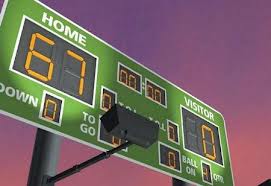 Nobody spends a lot of time and effort thinking and planning for the cupcake. This story feels like that. But it’s okay. Because Marvel Comics obviously didn’t go on to survive another 58 years by continuously baking cupcakes like this one.
Nobody spends a lot of time and effort thinking and planning for the cupcake. This story feels like that. But it’s okay. Because Marvel Comics obviously didn’t go on to survive another 58 years by continuously baking cupcakes like this one. 
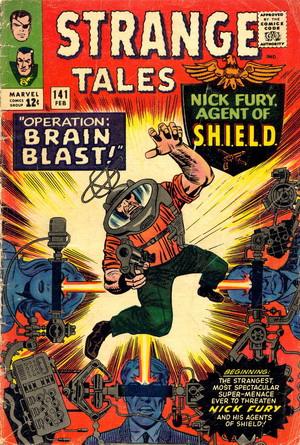
 demand a different course, he has no trouble going there. Especially when it comes to women. It only makes sense to treat a gal who’s treated you decently with the same amount of decency, rules be damned!
demand a different course, he has no trouble going there. Especially when it comes to women. It only makes sense to treat a gal who’s treated you decently with the same amount of decency, rules be damned! 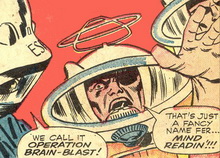 Steak and Sleep—and in a less G-rated comic he would surely have mentioned another “S” about bedding a broad. Then the picture would be complete.
Steak and Sleep—and in a less G-rated comic he would surely have mentioned another “S” about bedding a broad. Then the picture would be complete.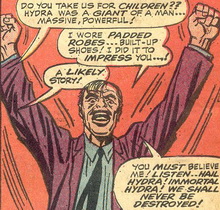 Imperial Hydra. Without his padded robe and “built up shoes,” this evil leader is unrecognizable, even by his own men, who see him as an imposter and kill him.
Imperial Hydra. Without his padded robe and “built up shoes,” this evil leader is unrecognizable, even by his own men, who see him as an imposter and kill him. 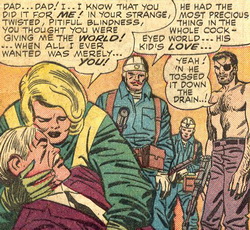 Yes, she is a decent person. She was never on board with any of this Hydra business. And it is only once her father lies dying in her arms that she cries out in sorrow, “Dad!…I know that you did it for me! In your strange, twisted, pitiful blindness, you thought you were giving me the world! …when all I ever wanted was merely…you!”
Yes, she is a decent person. She was never on board with any of this Hydra business. And it is only once her father lies dying in her arms that she cries out in sorrow, “Dad!…I know that you did it for me! In your strange, twisted, pitiful blindness, you thought you were giving me the world! …when all I ever wanted was merely…you!”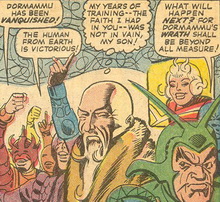
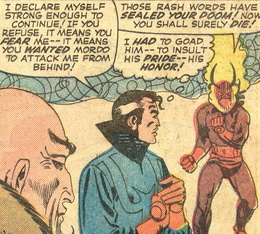 Doctor Strange uses reverse psychology on Dormammu to trick him into agreeing to a reprise of their hand-to-hand combat, goading him with “If you refuse, it means you fear me…!” Of course, Dormammu takes the bait. Then Strange hustles him, pretending to “stumble” so Dormammu will be duped into excessive confidence. Once Strange’s trap is laid…Dormammu falls right into it! Game over! (At least for the moment…)
Doctor Strange uses reverse psychology on Dormammu to trick him into agreeing to a reprise of their hand-to-hand combat, goading him with “If you refuse, it means you fear me…!” Of course, Dormammu takes the bait. Then Strange hustles him, pretending to “stumble” so Dormammu will be duped into excessive confidence. Once Strange’s trap is laid…Dormammu falls right into it! Game over! (At least for the moment…)
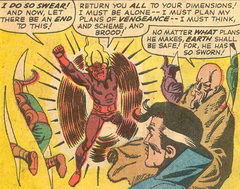 and in a fit of rage, Dormammu lets loose with uncontrollable fury. He’s tolerant, as long as the minion suits his needs, but the moment that line is crossed, Dormammu drowns poor Mordo in a heaping helping of what he really thinks about him.
and in a fit of rage, Dormammu lets loose with uncontrollable fury. He’s tolerant, as long as the minion suits his needs, but the moment that line is crossed, Dormammu drowns poor Mordo in a heaping helping of what he really thinks about him. he is still villainous enough to seek some wiggle room. This will require thinking, scheming…even “brooding.” These words paint a robust picture of a villain unable to give up his completely villainous ways. Maybe he better call Saul…
he is still villainous enough to seek some wiggle room. This will require thinking, scheming…even “brooding.” These words paint a robust picture of a villain unable to give up his completely villainous ways. Maybe he better call Saul… is that with as many appearances as we’ve had by this character, we still don’t know her NAME. And frankly, I’m getting tired of referring to her as “The Girl with the Crazy White Hair.” It’s awkward.
is that with as many appearances as we’ve had by this character, we still don’t know her NAME. And frankly, I’m getting tired of referring to her as “The Girl with the Crazy White Hair.” It’s awkward. “The End of Hydra!”
“The End of Hydra!”
 “The Pincers of Power!”
“The Pincers of Power!”
 “My Life For Yours!”
“My Life For Yours!”
 “Where Walks the Sleeper!”
“Where Walks the Sleeper!”
 “The Grandeur and the Glory!”
“The Grandeur and the Glory!”
 “Closer Comes the Swarm!”
“Closer Comes the Swarm!”
 “Those Who Would Destroy Us!”
“Those Who Would Destroy Us!”
 “From the Ashes of Defeat–!”
“From the Ashes of Defeat–!”

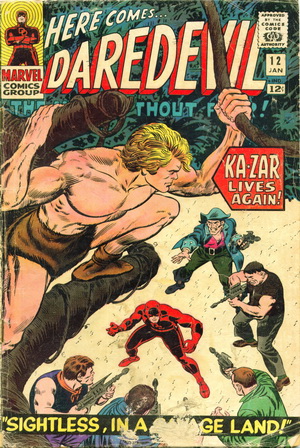

 Now. While it’s true that I can find some storylines challenging, I’m much more appreciative of a complicated character. And in this story, some of our characters in and of themselves are not exactly what they first appear to be. And that sparks my interest. Sometimes a character develops over time and circumstance, and sometimes they are merely slowly revealed, as in the peeling of an onion. Some onions will make you cry, but others prove very tasty.
Now. While it’s true that I can find some storylines challenging, I’m much more appreciative of a complicated character. And in this story, some of our characters in and of themselves are not exactly what they first appear to be. And that sparks my interest. Sometimes a character develops over time and circumstance, and sometimes they are merely slowly revealed, as in the peeling of an onion. Some onions will make you cry, but others prove very tasty.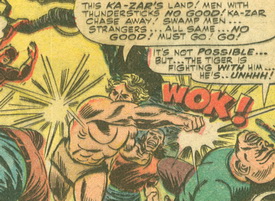
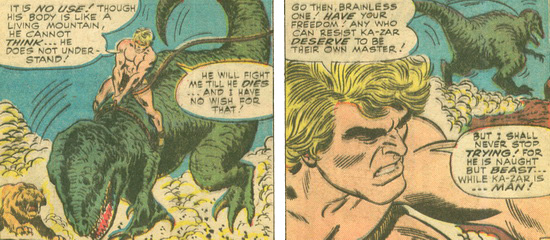
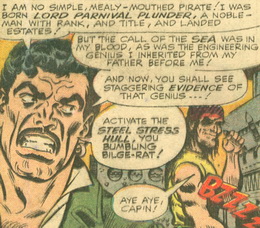 Plunder certainly seems interested in monetary gain early in the story, when he describes the cruise ship Odyssey as “what a prize,” and leads the boarding party with cries of “Empty your pockets!” But he abandons all that when he decides to take nothing more than Daredevil as hostage. Then, to Daredevil, he finally reveals his true motivation: Pride and Revenge toward all those who laughed at his dreams!
Plunder certainly seems interested in monetary gain early in the story, when he describes the cruise ship Odyssey as “what a prize,” and leads the boarding party with cries of “Empty your pockets!” But he abandons all that when he decides to take nothing more than Daredevil as hostage. Then, to Daredevil, he finally reveals his true motivation: Pride and Revenge toward all those who laughed at his dreams!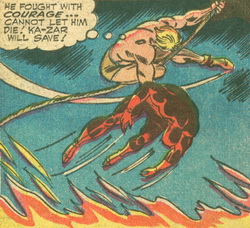 And Daredevil, upon hearing Plunder’s story, decides the pirate is actually noble.
And Daredevil, upon hearing Plunder’s story, decides the pirate is actually noble.  Longtime readers of this blog may know that I am a fan of college football. Several years back, I harbored quite a soft spot for Tim Tebow, since he is a Florida boy attending my alma mater and is about the same age as my son. So I’ve always felt sort of motherly toward him, and the weekend he first returned to the field after a concussion, I was extremely worried about him on every play. Eventually that worry faded and we got back to football as usual, but I’m wondering if now I’ll fall into a similar pattern of worrying about Daredevil every time he gets into hand-to-hand combat with an opponent who could potentially give him a concussion.
Longtime readers of this blog may know that I am a fan of college football. Several years back, I harbored quite a soft spot for Tim Tebow, since he is a Florida boy attending my alma mater and is about the same age as my son. So I’ve always felt sort of motherly toward him, and the weekend he first returned to the field after a concussion, I was extremely worried about him on every play. Eventually that worry faded and we got back to football as usual, but I’m wondering if now I’ll fall into a similar pattern of worrying about Daredevil every time he gets into hand-to-hand combat with an opponent who could potentially give him a concussion.












